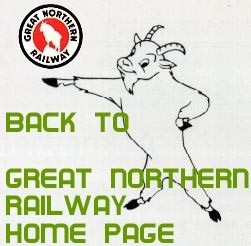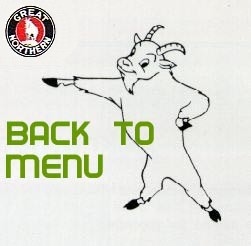|


| |
Continued from Page 6
...cut back in 1962, maintenance programs on track and equipment were continued
without deferment of essential work. The property was in good shape at year's
end.
Improvements in Facilities
Great Northern's expenditures for additions and betterments in 1962 totaled
$10.0 million, with $5.7 million for roadway and structures and $4.3 million for
equipment. A considerably heavier capital program, anticipating expenditures of
$25.3 million, is planned for 1963.
Routine replacements of rail and ballast commanded a large share of the capital
expenditure money for roadway and structures in 1962. Fifty-three miles of main
line received new 115-pound rail, much of it continuously welded in quarter-mile
sections, while secondhand rail was used in relaying 64 miles of secondary
lines. The principal project other than track work was continuation of the major
line change begun in 1961 in the vicinity of Index, Washington, and designed to
reduce sharp curves and permit higher speeds with less maintenance work.
Our 1962 equipment program was concentrated on the specialized equipment
pictured on page 10, and on the continued upgrading of box cars to modern
standards. Shop forces in St. Cloud restored 1,000 older cars to high-grade
condition, replacing original wood sheathing with steel sides. Also constructed
in company shops at St. Cloud were 15 new all-steel cabooses.
To keep pace with the rapidly-growing automobile, GN acquired 60 bi-level and
tri-level racks for application to long flat cars, mostly those of the Trailer
Train Company pool in which we participate as part owner.
A major property improvement slated for 1962 is installation of 121.9 miles of
centralized traffic control in two areas of high traffic density - between
Juanita and Aylmer, North Dakota, and Chester and Shelby, Montana. Remote
control of switches will be from existing CTC installations at Minot and Havre.
Work will be continued on the Index line change and on a major communication
project to convert all principal telephone circuits to direct dialing.
Included in the 1963 track program is the laying of 75 miles of new rail and 106
miles of secondhand material, together with the application of 448,000 cubic
yards of ballast.
Principal items of new equipment to be acquired in 1963 are 17 new 2250 hp
diesel-electric freight units, 700 new box cars and 140 cars of other types. All
of the box cars will be 50 foot or longer and equipped with roller bearing
trucks.
Traffic Development and Service
Piggybacking continued to grow in volume and diversity during 1962. Revenues of
$3,170,000 did not represent a large percentage of the freight total, but like
the rack movement of new automobiles (see back cover) TOFC was particularly
attractive for its rapid rise and its growth potential.
Efforts were made to broaden the scope of TOFC rates for entry into those fields
in which private trucks have been especially active...meat and packing house
products from the Middle West to the Pacific Northwest, dressed frozen turkeys
from Minnesota to the East, fruits from the Wenatchee area to the East and lime
from Duluth to the Dakotas.
Dependability of GN freight service reached a notably high level in 1962, as
evidenced by the record of freight train No. 402 between Seattle and the Twin
Cities. Providing daily scheduled service over a run of nearly 1,800 miles on
the fastest schedule ever published, the first two sections of this train, which
operate the full distance, had an average on-time performance of 97.2% during
1962!
Ninety industries located new facilities or expanded older plants during 1962 on
trackage served by Great Northern.
Among the larger facilities completed or nearing production in 1962 were:
Permanente Cement Company's $10 million cement manufacturing plant near Helena;
the Anaconda Company's new $30 million copper concentrator at Butte; the huge
new plywood plant opened at Libby by the J. Neils Division of St. Regis Paper
Company; and the $15 million expansion program of the Blandin Paper Company at
Grand Rapids.
Personnel Matters
News of Great Northern and its people and of significant developments in the
broad area of employe and labor relations have been reported regularly through
the year in the columns of TALKING IT OVER. It is appropriate, however, to
recall here a few items of particular "family" interest in 1962.
In the seventh year of competition for four-year college scholarships awarded
annually by GN to sons of employes, the winners were John E. Beacom, Daniel J.
Kennedy and Kenneth Kosai. They are the sons of J.F. Beacom, conductor, Sioux
Falls; D.M. Kennedy, coach cleaner, Vancouver, B.C., and Kiso Kosai, tractor
driver, Spokane. All Great Northern employes share the parents' pride in these
youths, who soon will complete their freshman years, respectively, at Creighton
University, the University of British Columbia and the California Institute of
Technology.
It is pleasing to note that a substantial reduction in the rate of employe
injuries was achieved in 1962. The ratio of deaths and injuries resulting in
loss of time for one day or more was 6.65 per million man hours, compared with
an 8.68 ratio in 1961.
Activity in the vitally important fields of public safety and industrial
accident prevention brought Great Northern awards from the National Safety
Council and the Minnesota Safety Council.
Another significant award which focused favorable attention on the railway was a
special citation to our Dining Car Department for excellence in sanitation
aboard GN dining cars. Great Northern became the first transcontinental railway
to win this coveted United States Public Health Service citation five
consecutive years.
 
 
|